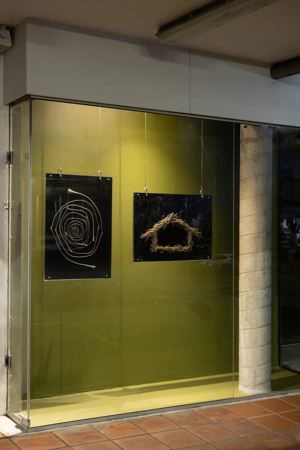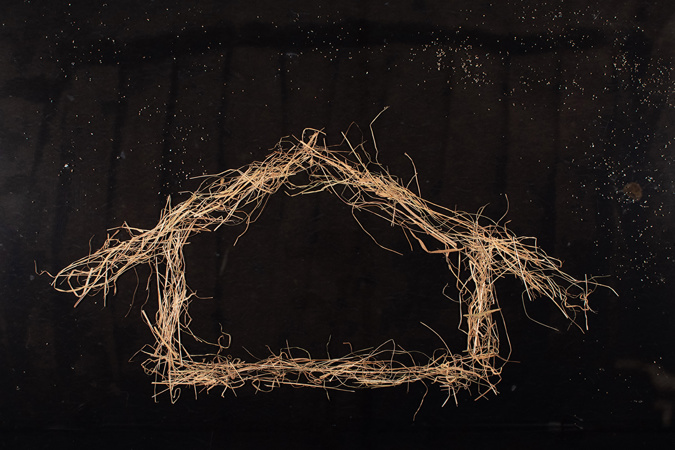George Watson: Open Window
05 Aug 2023 - 11 Feb 2024
Tūranganui-a-Kiwa based artist George Watson (Ngāti Mutunga, Moriori, Ngāti Porou) creates a new commission for the Gallery’s street-front Open Window, responding to Te Hau Whakatonu: A Series of Neverending Beginnings – a showcase of Toi Māori from the Govett-Brewster’s permanent collection.
Piko rauru, 2023
Rikoriko, 2023
I roto i ngā mahi a te ringatoi nei, a George Watson o Tūranganui-a-Kiwa, e whakamahia ana ngā kōrero o ngā mahinga toi ā ngā Tāngata Whai, me ā ngā Tāngata Māori, me tā ngā tirohanga tauaro ki te ao hanga i ngā hononga rerekē ki te ao tūroa, ki te tinana anō hoki. I roto i āna mahi o Window Watson, he kohinga tānga pikitia hangaia ki te hei me te muka, ā, e uruhi ana ki runga whakaahua o te hope perehi, me te rārangineka o tētehi panekoti Wikitōriana i kākahutia e tētehi o ngā tupuna Ingarihi o te ringatoi. He hokinga mahara te atanga ki te aukatinga o ngā kākahu wahine Wikitōriana, waihoki ā tērā wā perehi putiputi, he runaruna hāngai pū ki te kōmakataga.
Kōpeketia ana i waenga i ngā hīti kiriaku, ā whakatārewa poutū atu ai, e mau pupuru ana ēnei pikitia i te tanuku. Ko te taitara nei a Piko Rauru, e hāngai ana ki te tauira e tohu ana i te ora, i te oke, i konei kua tāngia ki te taura muka o te harakeke, he taonga e mōhio nuitia ana i tana kaha. Ko te nōhanga māori o te harakeke kei ngā tahataha o te wai. I roto o Rikoriko, kua hangaia te pikitia o te wharenui ki te hei, ko ngā hei, he hua nō te pātītī, he ahuwhenua tauhou e hono tika atu ana ki te murunga o ngā whenua Māori, ki te ununga o ngā repo, ki te tāhoronga o te wao. Kei te tauritenga o ēnei pikitia tētehi whakahaunga a Watson,e mea ana kia whai whakaaro tātou ki te tukuihotanga o ngā whakahaere whai oranga ki te whenua, ki ngā taonga, ki ngā momo taketake, me ngā ritenga ahurea anō hoki.
E taupatupatu ana te ngoikore o te hei ki te pikitia o te wharenui, e tohu ana tērā i te mārohirohi me te orangatonutanga o tētehi hapori mau kaha nei ki te hononga ki ngā tūpuna. Ko ngā whetū i hangaia ki te anga pāua – he rite tonu tā ngā kai whakairo whakamahi i te anga pāua hei kanohi – he tohu nō te mataaratanga, nō te manawanuitanga hoki, te tiro mākutu, te hārau manaaki ā ngā tūpuna ki ā rātou uri. I roto i te herenga o ngā rawa, o ngā pikitia me ngā momo, e whakakōrerohia e ēnei mahi te ‘ngoi o te whakarauoratanga o te ahurea i te aroaro o ngā tini wero’.
In her practice, Tūranganui-a-Kiwa-based artist George Watson draws upon the sensibilities of settler New Zealand and Māori visual languages as contrasting world views that shape differing relationships to the natural world and the body. In the Open Window Watson’s works comprise drawings in hay and muka imposed over photographs of the pleated waist and neckline of a Victorian dress worn by one of the artist’s British ancestors. The imagery recalls the restriction of Victorian women’s clothing, as well as the Victorian pastime of pressing flowers, a hobby based in the science of classification.
Compressed between acrylic sheets and suspended vertically, these images are held in place through tension. The title Piko rauru refers to the double spiral motif that suggests movement, here drawn in muka cordage–prepared harekeke fibre–a taonga material renowned for its strength. The natural habitat of harakeke is along waterways. In contrast, in Rikoriko the image of a wharenui (meeting-house) is created using hay, made from grasses introduced as part of imported agricultural practices which are historically entwined with the dispossession of Māori land, draining of swamps, and razing of bush. In pairing these drawings, Watson prompts us to consider the legacies of inherited land management practices upon the well-being of the whenua, taonga species and cultural practices.
The brittleness of hay is at odds with the image of the wharenui it describes, which is emblematic of the strength and continuity of a community bound by ancestral ties. The whetū (stars) in the night sky are created from crushed Pāua shell—a taonga often utilised as an inlay for eyes on carved figures—a symbol of vigilance and persistence, the watchful gaze of tūpuna (ancestors) upon their uri (descendants). In binding together materials, images and forms, these works speak to ‘the strength of cultural revitalisation in the face of many challenges’.


